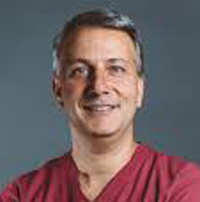
Massimo Caputo
British Heart Foundation (BHF) Professor of Congenital Heart Surgery, University of Bristol
Stem cell therapy and tissue engineering are offering new hope for longer-term treatment solutions for children with congenital heart disease (CHD).
Children born with congenital heart disease face the prospect of multiple operations as their bodies grow.
Synthetic materials to correct defects do not grow with their bodies, rapidly degenerate and need replacing, meaning children undergo three or four operations as they grow into young adults. But tissue engineering and stem cell therapy research are offering an innovative solution.
Massive progress
Massimo Caputo, BHF Professor of Congenital Heart Surgery at the University of Bristol, says the massive progress in child cardiac surgery over the last three decades with increased survival rates has created a new problem.
“These children come back for more operations because the material we use in surgery to correct and restore the anatomy is prosthetic and rapidly fails,” he adds.
Consequently, it does not grow with the child and can degenerate, meaning it needs replacing with repeated high risk open-heart operations. These can lead to psychological, as well as general, health problems with the repeated surgeries.
The massive progress in child cardiac surgery over the last three decades with increased survival rates has created a new problem.
Stem cells
Professor Caputo is working on research that focuses on using stem cells to bio-engineer tissues that ‘grow’ with the patient to avoid those repeated operations.
Coupled with 3D printing and bio-printing to create accurate anatomical models of the material, the approach uses cells harvested from the mother’s umbilical cord as a diagnosis of CHD can be made during pregnancy.
Working with an NHS-approved gene and cell therapy unit at the Royal Free Hospital in London, a collaborative research programme (sponsored by the British Heart Foundation, The Sir Jules Thorn Charitable Trust and The Linder Foundation) aims to produce stem cell-seeded grafts that can be inserted during the corrective open-heart procedures in children born with heart defects.
Donor stem cells from umbilical cord tissue have been recently used at the Bristol Royal Hospital for Children on a sick baby, who is now aged one and thriving. But while the safety of the cell approach has been shown, the research has to undergo further efficacy trials and regulatory steps.
Clinical need
COVID-19 has slowed the research, but Professor Caputo hopes a product will be ready for trials in children within the next two years, with the aim of making such therapy more broadly available to treat CHD.
“We do need to find a better biological solution for the material we use in congenital heart surgery and we feel that stem cell technology is the way forward,” he adds.
“There is a real clinical need. If we do not find a better solution, we will really struggle to improve the long-term quality of life for these children.”




